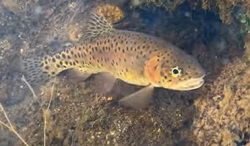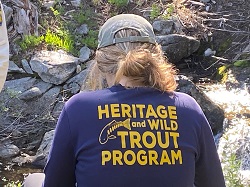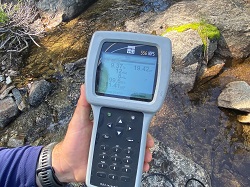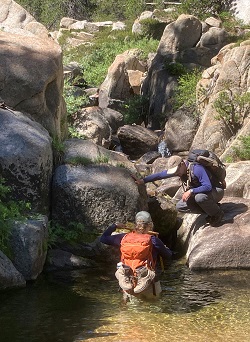CDFW Scientific Aid Stew Sloan measures pool depth at Pacific Creek.

A Lahontan cutthroat trout swims within Milk Ranch Creek.

Environmental Scientist Allison Scott records data on the banks of Pacific Creek.

A handheld multiparameter instrument displays several creek measurements at once.

CDFW's Allison Scott and Aaron Sturtevant measure pool depth within Milk Ranch Creek.
As holiday visitors vacated the Stanislaus National Forest at the conclusion of the long Fourth of July weekend, the California Department of Fish and Wildlife’s (CDFW) Heritage and Wild Trout Program moved in.
Four team members from the statewide program – Environmental Scientist Allison Scott, scientific aids Aaron Sturtevant and Stew Sloan, along with new program leader Farhat Bajjaliya – set up camp within the border region of Alpine and Stanislaus counties in the northern reaches of the Eastern Sierra.
The team spent the better part of three days rock-hopping, climbing and carefully picking their way upstream along three small creeks within the high elevations of the Carson-Iceberg Wilderness searching for and counting wild Lahontan cutthroat trout (Oncorhynchus clarkii henshawi). The goal was to see how the fish and their habitat were faring in a third summer of California drought. Along the way, the team paused regularly to record water temperatures, creek flows and dissolved oxygen levels and take pool depth measurements. They took photos, referenced waypoints on their Garmin unit and thoroughly explored any smaller tributaries feeding into the main creeks, some just a couple inches deep at points.
“One of the things we really key in on is pool habitat,” explained Bajjaliya. “When drought conditions get really bad, that’s where the fish will go and seek refuge so we want to keep an eye on that.”
The three small creeks surveyed – Marshall Canyon Creek, Pacific Creek and Milk Ranch Creek – share similar characteristics.
Their lower reaches are occupied by introduced non-native brook trout (Salvelinus fontinalis). Various impenetrable natural barriers such as steep, cascading waterfalls or sheer granite rock cliffs prevent the brookies from accessing the higher-elevation stretches home to the Lahontan cutthroats. The Lahontan cutthroat trout themselves are not necessarily native either as these particular creeks are situated outside of their historic watersheds. The fish were put there decades ago by biologists to serve as refuge populations just in case the fish, a federally listed threatened species, disappeared elsewhere within their native range.
CDFW’s trout team hiked almost 10 miles each day carrying a mix of high-tech and low-tech equipment. On one end of the technology spectrum was the YSI handheld digital “multiparameter instrument,” which simultaneously measures pH levels, dissolved oxygen, temperature and the ability of the water to absorb and break down waste products such as contaminants and dead plants and animals. On the other end of the spectrum was the collapsible stadia rod. Resembling a folding yardstick, it’s used to measure pool depth and creek width. No electrofishing gear was packed in. Lahontan cutthroat trout were counted and sized only through visual observations – and often fleeting observations at that.
The scientific work is formally known as drought stressor monitoring and it makes up a significant portion of the Heritage and Wild Trout Program’s field season, which stretches from May to November and occurs across the state wherever sensitive native trout populations exist. The program’s environmental scientists and part-time scientific aids typically spend eight consecutive days in the field followed by six consecutive days off work.
The value of this type of hands-on, eyes-on field work was driven home during California’s last drought. Drought monitoring surveys similar to the ones within the Carson-Iceberg Wilderness led to the dramatic rescues of McCloud River redband trout (Oncorhynchus mykiss stonei) and California golden trout (Oncorhynchus mykiss aguabonita) – the official state freshwater fish.
Drought monitoring in the summer of 2014 revealed deteriorating habitat conditions near Mount Shasta and prompted the rescue of McCloud River redband trout (Video) from four creeks among the headwater tributaries of the McCloud River. With no suitable options available to relocate the fish on the landscape, CDFW took the unusual step of bringing the wild trout – a designated state species of special concern – into its Mount Shasta Trout Hatchery until they could be returned to their native habitat when environmental conditions improved.by the fall of 2016.
While at the hatchery, CDFW was able to successfully spawn the redbands. The Mount Shasta Trout Hatchery has maintained a broodstock population ever since and stocks their offspring into local waters for recreational fishing to expose more trout anglers to this colorful and rare native species.
Drought stressor monitoring led to the September 2016 rescue of California golden trout from Volcanic Creek, situated high in the southern Sierra Nevada range at 9,000 feet within the Inyo National Forest. Fifty-two fish – a representative sample that could repopulate Volcanic Creek and save the genetically pure strain of goldens if conditions worsened – were collected and taken to the American River Trout Hatchery near Sacramento to wait out the drought before being returned to their native habitat in 2017 (Video) when environmental conditions improved.
The Lahontan cutthroat trout is in a far more precarious situation than either the McCloud River redband trout or the California golden trout. Lahontan cutthroat trout were listed as an endangered species by the federal government in 1970 – three years before the modern, federal Endangered Species Act was signed into law in 1973 by President Richard Nixon. The fish have languished as a federally listed species ever since. Their status was downgraded to “threatened” in 1975 but only to allow for more aggressive management and recovery efforts and to allow recreational fishing.
Once occupying a vast range east of the Sierra Nevada, Lahontan cutthroat trout have disappeared from nearly 95 percent of their native habitat in California, which includes Lake Tahoe, the Carson, Truckee, and Walker river basins, as a result of habitat degradation and competition from non-native trout.
The 50th anniversary of the species’ federal listing in 2020 was something of an ignominious milestone. Several state and federal agencies – including the U.S. Fish and Wildlife Service, the USDA Forest Service, CDFW and the Nevada Department of Wildlife – have joined forces recently to redouble efforts and accelerate Lahontan cutthroat trout recovery.
All of which helps explain why keeping close tabs on the few remaining wild, self-sustaining, genetically pure populations of Lahontan cutthroat trout left in California is a priority for CDFW and the Heritage and Wild Trout Program specifically.
Back at the Carson-Iceberg Wilderness within the Stanislaus National Forest in July, the day’s drought monitoring work ends when 200 Lahontan cutthroat trout have been tallied or the habitat simply disappears back into the ground at the headwaters source or becomes otherwise impenetrable by either fish or human.
At all three creeks, the trout habitat ran out before 200 fish were counted. The team observed 153 Lahontan cutthroat trout at Milk Ranch Creek, 33 in Marshall Canyon Creek and 23 at Pacific Creek. The team seemed satisfied with what it saw.
The habitat was holding up well for early summer conditions and enough Lahontan cutthroat trout – mostly 6 inches and shorter in length – were observed in the wildflower-laden, meadow sections of each creek’s upper reaches. The numbers of fish were reasonably consistent with drought monitoring conducted in 2020 and 2021. The numbers of fish observed in Marshall Canyon Creek and Milk Ranch Creek exceeded the numbers counted the previous two years.
No fish were spotted in the steeper, faster, rockier, lower portions of the creeks. No emergency rescue missions were discussed.
“There really is no reason for them to leave the meadows,” explained CDFW’s Scott. “That’s where the best habitat is and there are not so many fish that some are forced to move out.”
Media Contacts:
Farhat Bajjaliya, CDFW Heritage and Wild Trout Program, (916) 215-5330
Peter Tira, CDFW Communications, (916) 215-3858